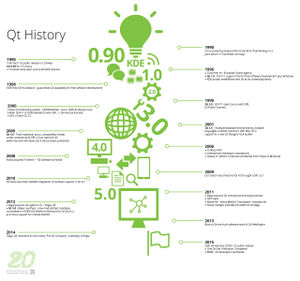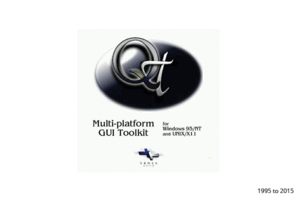About Qt
What is Qt?
Qt is a cross-platform application development framework for desktop, embedded and mobile. Supported Platforms include Linux, OS X, Windows, VxWorks, QNX, Android, iOS, BlackBerry, Sailfish OS and others.
Qt is not a programming language by its on. It is a framework written in C++. A preprocessor, the MOC (Meta-Object Compiler), is used to extend the C++ language with features like signals and slots. At compile-time the MOC parses the source files written in Qt-extended C++ and generates standard compliant C++ sources from them. Thus the framework itself and applications using it can be compiled by any standard compliant C++ compiler like Clang, GCC, ICC, MinGW and MSVC.
The Qt Company and The Qt Project
Development of Qt was started in 1990 by the Norwegian programmers Eirik Chambe-Eng and Haavard Nord. Their company Trolltech, that sold Qt licenses and provided support, went through several acquisitions over the years. Today former Trolltech is named The Qt Company and is a wholly owned subsidiary of Digia Plc., Finland. Although The Qt Company is the main driver behind Qt, Qt is now developed by a bigger alliance: The Qt Project. It consists of many companies and individuals around the globe and follows a meriocratic governance model.
License
Qt is available under various licenses: The Qt Company sells commercial licenses, but Qt is also available as free software under several versions of the GPL and the LGPL (Licensing FAQ).
Build System
Although any build system can be used with Qt, Qt brings its own qmake. It is a cross-platform front-end for platform-native build sytems, like GNU Make, Visual Studio and Xcode.
IDE
Qt comes with its own Integrated Development Environment (IDE), named Qt Creator. It runs on Linux, OS X and Windows and offers intelligent code completion, syntax highlighting, an integrated help system, debugger and profiler integration and also integration for all major version control systems (e.g. git, Bazaar). In addition to Qt Creator developers on Windows can also use Qt's Visual_Studio_Add-in. Other IDEs (e.g. KDevelop on KDE) can also be used. But of course it is in no way mandatory to use any IDE at all.
Internationalization and Localization
Qt features excellent support for internationalization (i18n) and localization (l10n). The tool Qt Linguist and its companions lupdate, lrelease and lconvert make it easy to translate applications to locale languages. Qt supports most languages and writing systems that are in use today. For a complete listing see the corresponding manual pages.
Widgets
With Qt, GUIs can be written directly in C++ using its Widgets module. Qt also comes with an interactive graphical tool called Qt Designer which functions as a code generator for Widgets based GUIs. Qt Designer can be used stand-alone but is also integrated into Qt Creator.
QtQuick
Another way to write GUIs with Qt is to use the QtQuick module. GUIs using QtQuick are written in QML. QML is a declarative object description language that integrates Javascript for procedural programming. QtQuick provides the necessary modules for GUI development with QML. It is possible to write whole applications in QML only, but usually only the GUI is written in QML and the application's backend is implemented in C++ (see Integrating QML and C++). Also Qt Creator features an integrated QtQuick GUI designer and profiler.
More Modules
Not being limited to GUIs, Qt contains modules for cross-platform development with: networks, databases, OpenGL, web content, special hardware (like sensors, Bluetooth, serial ports, NFC, touch devices, graphics tablets), XML and JSON processing, printing and PDF generation. Even more modules are commercially available from The Qt Company and various others.
Language Bindings
Although applications using Qt are usually written in C++ and QML bindings to other languages exist. These are not part of Qt but are provided by various third parties. Riverbank Computing for example provides commercial and free software Python bindings (PyQt). For more language bindings see Category:LanguageBindings.
Facts and Figures
- One million downloads of Qt 5.3 measured just over a month after launch.[1]
- 250+ commits by 60+ contributors per week[2]
- Leading companies and organizations in over 70 industries use Qt to power millions of devices and applications[3], including, but not limited to:
- Main companies contributing to Qt in 2015[2]:
- The Qt Company (Finland)
- KDAB (Sweden)
- AudioCodes (Israel)
- Intel (USA)
- Intopalo (Finland)
- Jolla (Finland)
- BlackBerry (Canada)
- Woboq (Germany)
- Service partners of The Qt Company[13]:
- Technology partners[13]:
- Adeneo Embedded (France)
- ARM (UK)
- Boundary Devices (USA)
- Freescale Semiconductor (USA)
- froglogic (Germany)
- SILICA (Germany)
- Texas Instruments (USA)
- Toradex (Switzerland)
- V-Play (Austria)
- Community partners[13]:
History
- “In the summer of 1990, Haavard [Nord] and Eirik [Chambe-Eng] were working together on a C++ database application for ultrasound images. The system needed to be able to run with a GUI on Unix, Macintosh, and Windows. One day that summer, Haavard and Eirik went outside to enjoy the sunshine, and as they sat on a park bench, Haavard said, “We need an object-oriented display system.” The resulting discussion laid the intellectual foundation for the object-oriented cross-platform GUI framework they would soon go on to build.”[14]
- Release history
References
- ↑ http://www.digia.com/en/Company/News/Digia-Announces-The-Qt-Company-Launches-a-Unified-Website-and-Unleashes-a-20-Indie-Mobile-Monthly-Subscription-Plan/
- ↑ 2.0 2.1 Thiago Macieira's blog
- ↑ http://www.qt.io/qt-in-use/
- ↑ http://web.archive.org/web/20110723145813/qt.nokia.com/qt-in-use/story/customer/esa-european-space-agency
- ↑ http://web.archive.org/web/20110723145736/qt.nokia.com/qt-in-use/autodesk/
- ↑ http://web.archive.org/web/20110723145736/qt.nokia.com/qt-in-use/autodesk/
- ↑ http://www.businesswire.com/news/home/20071015006427/en/Lucasfilm-Ltd.-Trolltechs-Qt-Create-User-Interface#.VXCnRq3tmko
- ↑ http://web.archive.org/web/20110714191507/qt.nokia.com/qt-in-use/story/customer/walt-disney-feature-animation
- ↑ http://web.archive.org/web/20110714191457/qt.nokia.com/qt-in-use/story/customer/volvo-mobility-systems
- ↑ http://web.archive.org/web/20110714191438/qt.nokia.com/qt-in-use/story/customer/siemens
- ↑ http://web.archive.org/web/20110723145947/qt.nokia.com/about/news/panasonic-selects-qt-for-hd-video-system
- ↑ https://developer.valvesoftware.com/wiki/Qt
- ↑ 13.0 13.1 13.2 https://www.qt.io/partners/
- ↑ Blanchette, J & Summerfield, M. (2006). C++ GUI Programming with Qt 4. Prentice Hall.

